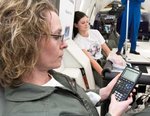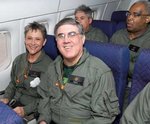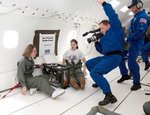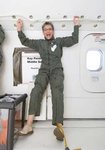





Erica Ma, Hugh McMillan,, and Rodika Tollefson, KP News
Nearly everyone, at some point in time, has combined vinegar and baking soda together, reveling in the chemical reaction that results. However, what happens when the two are combined in a weightless environment? Will the chemical reaction differ? Presented with those questions, a NASA team from KPMS set off to find the answer.
Amy D’Andrea, Kathy Tucker-Patton, Ron Stark, and Brianna Randall, the four teachers/test subjects, flew to Houston, Texas, in February to try out the experiment aboard NASA’s “Weightless Wonder,” a modified McDonnell Douglas DC-9 capable of executing a series of parabolic maneuvers to produce about 25 seconds of weightlessness. (To produce each weightless moment, the DC-9 makes a steep climb followed by an equally steep dive, when everything not nailed down floats.) KPMS was one of 20 NASA Explorer schools selected for the activity.
The teachers were joined by former KPMS students John DeLeo (now Peninsula High senior) and Brett Knisely (now a physics student at Washington State University), who served on the ground crew at Johnson Space Center’s Ellington Field.
The many twists and turns of the jet may cause dizziness and nausea, hence the famed nickname “the vomit comet.” The teachers were advised to prepare accordingly. There were two trials; the first done by D’Andrea/Randall and the second by Tucker-Patton/Stark. Both groups claimed they were nervous at first, but ended up enjoying the ride.
After the first trial, the crew held a live video conference with several KPMS science classes. “The most exciting part of the experiment was actually performing it in microgravity… It was a lot different than practicing it at KPMS! The syringes were harder to plunge, and the body positioning was different than expected,” Randall described during the conference. “We didn’t know how our bodies were going to react to the G-forces and microgravity, so we had a lot of ‘unknown’ elements to deal with, and most of the time, unknown is scary!”
Despite those little snags, they were treated like professionals. D’Andrea, the KPMS team leader, said in an interview upon return the project was very well organized by NASA staff, who “lived up to their every word.” The flights weren’t just for show either: During D’Andrea’s flight, two NASA scientists from the Glenn Research Center were aboard with a “real” experiment.
To the relief of the team and the slight disappointment of the students, no actual vomiting was involved. KPMS teachers successfully completed their “missions,” and data concerning chemical reactions in weightless environments was collected. Eighth-grade astronomy students will finish analyzing the data from the experiment, comparing it to the data collected by KPMS students under normal gravity conditions.
“This opportunity is one more connection our students are able to make with the STEM (science technology, engineering and math) community through collaboration with NASA scientists and engineers,” said KPMS science teacher Kareen Borders, who initiated the process that turned KPMS into a NASA Explorer School. “We are very proud of our students.”
This is the last year of the three-year KPMS partnership with NASA that is designed to inspire future science, technology, engineering and mathematics professionals. KPMS was the first of two NASA Explorer Schools in Washington and has taken part in many unique, NASA-sponsored activities to help address the math and science needs of its students. Recently, KPMS’ participation in the Explorer Schools program was recognized by state Superintendent of Public Instruction Terry Bergeson, who highlighted it as one of three middle schools making exceptional progress in Washington state.
By investing in the nation’s education programs, NASA’s goal is to attract and retain students in science, technology, engineering and mathematics, or STEM, disciplines. To compete for the minds, imaginations, and career ambitions of America’s young people, the space agency seeks to encourage the students’ pursuit of educational disciplines critical to its missions.
DeLeo, despite graduating from KPMS before the Explorer program began, is one example of how NASA’s approach is working. The Key Pen resident is interested in aerospace and plans to study engineering in college. Visiting the Johnson Space Center, watching “mission control” in action and interacting with the engineers “was an awesome experience” for him — and he hopes to work for NASA some day. He passed that excitement on to KPMS students during the video conference from Texas.
“It impacted our kids a lot,” D’Andrea said. “(His) message was, ‘Do well in school, and you, too, can do cool things.’”
Tucker-Patton had some inspirational advice of her own: “From what I saw, everyone who worked for NASA loved, loved their jobs,” she told the students. “Investigate careers with which you may not be entirely familiar. The sky’s the limit and failure is not an option!”
Excellent advice for the students, it applies to the adults as well. D’Andrea was fascinated to see the science behind NASA’s explorations. “What humans are doing is incredible,” she said. Like DeLeo, she left Houston thinking that a job with NASA could be cool, indeed.
“If there is a place for me at NASA some day, don’t be surprised,” she said.
Photos courtesy NASA
UNDERWRITTEN BY THE FUND FOR NONPROFIT NEWS (NEWSMATCH) AT THE MIAMI FOUNDATION, THE ANGEL GUILD, ADVERTISERS, DONORS AND PEOPLE WHO SUPPORT INDEPENDENT, NONPROFIT LOCAL NEWS